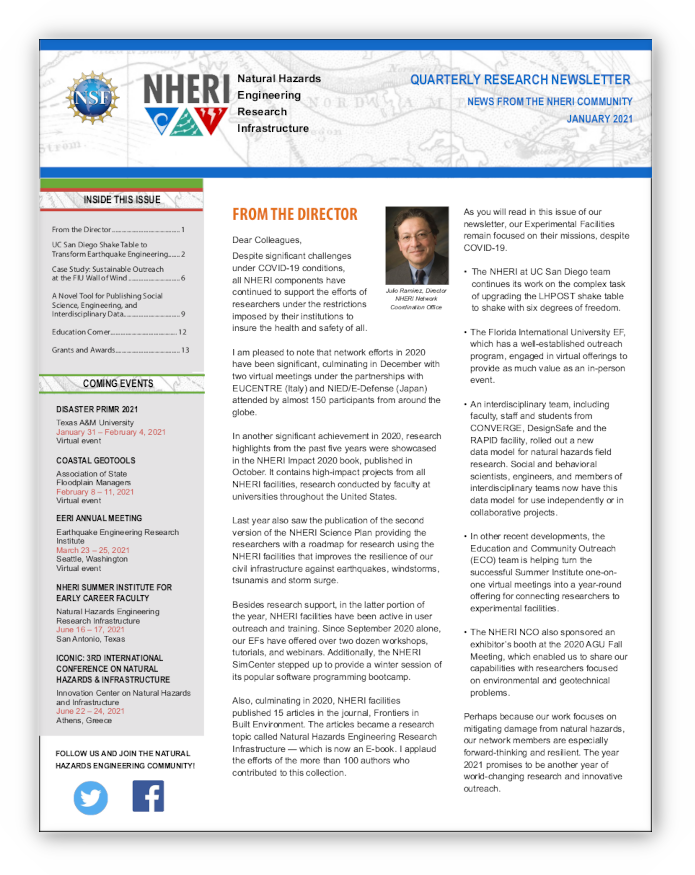Case Study: Sustainable Outreach at the FIU Wall of Wind
Published on January 13, 2021
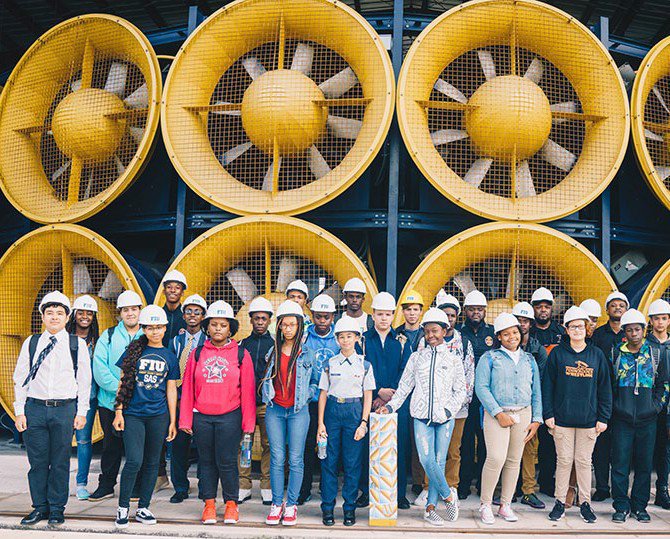
During the tour, WOW volunteers safely escort students to see the 12 large fans on the one end of the facility, and then to see the turntable where structures are tested by hurricane force winds on the other end. Students learn how the Wall of Wind works, see examples of research projects, and hear about wind engineering STEM careers. Getting a group picture in front of the fans is always a highlight.
Wind engineers particiapte in university events, partner with a STEM museum, and sponsor an annual engineering challenge
For nearly a decade, the Wall of Wind experimental facility at Florida International University has been the center of multiple successful and sustainable outreach programs. The WOW is integral to the International Hurricane Research Center and Extreme Events Institute, both at FIU, whose faculty and staff are enthusiastic advocates of STEM education.
Erik Salna directs outreach at the IHRC and the EEI, and hes created a portfolio of outreach programs that may serve as models for other NHERI EFs. In this case study, we touch on three primary efforts developed by Salna and FIU. The WOW participates big in FIUs annual Engineering Expo; it has a permanent exhibit and long-term partnership with a Fort Lauderdale science museum; and the WOW sponsors an annual engineering challenge event for local high schoolers.
PARTICIPATING IN THE ENGINEERING EXPO
FIUs College of Engineering and Computing holds an annual Engineering Expo, as many colleges do. At FIU, the expo is the engineering schools primary outreach event, a flashy affair with more than 1,600 students from Miami Dade and Broward County schools attending. Elementary, middle and high school students flock to campus where they interact with engineering students, researchers and staff and get a first-hand view of the FIU engineering campus and labs, including the Wall of Wind. The Wall of Wind team participates in the Engineering Expo by conducting tours of the NHERI Wall of Wind, which is located a mile from the main campus.
Effort: Relatively low from WOW Team. Requires advance organization, limited team member participation.
Value: Moderately high. At each expo event, 400-600 local children have a chance to see the massive WOW facility. Provides engagement experience to current engineering students.
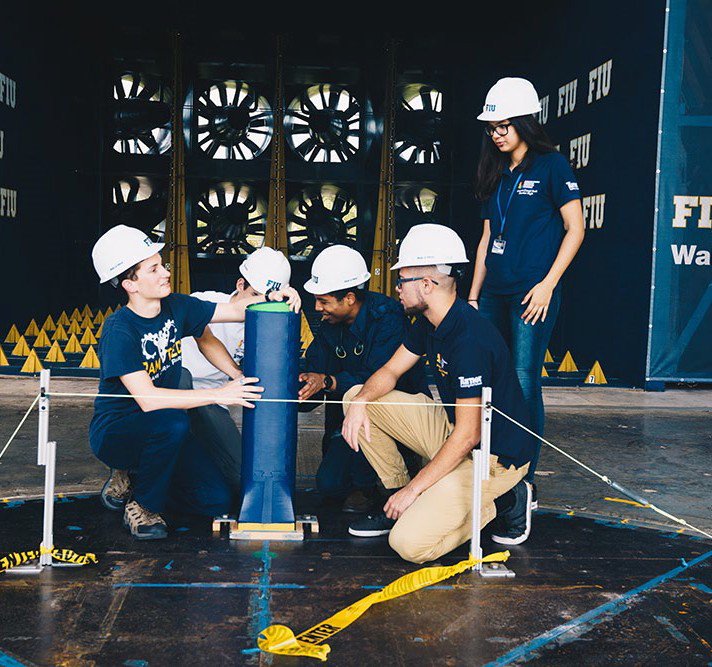
Students setting up a test for the WOW Challenge.

Participants in the Wall of Wind Challenge must make an oral presentation.
ESTABLISHING MUSEUM CONNECTIONS
The Wall of Wind enjoys a special relationship with the Museum of Discovery and Science (MODS), located in Fort Lauderdale, about 40 miles northeast of campus. Local science museums often seek connections with local science experts and partnerships with local universities for developing informal education projects. Salna helped develop an interactive Wall of Wind exhibit for the museum that illustrates the effects of wind on different roof shapes, teaches the science of wind engineering, and shows the importance of mitigating wind damage to your home. A video loop shows examples of wind testing by the real Wall of Wind. Display panels highlight successful research at the WOW.
In May, just before hurricane season begins, the museum holds an annual Eye of the Storm Hurricane Education Day, a hands-on free event, and the Wall of Wind exhibit is a central feature. Salna arranges for WOW researchers and FIU wind engineering students to greet and educate families and kids while operating the exhibit. They engage younger kids with a building challenge, which is to create a tower using paper and tape and test it for stability using a portable fan. Its a popular activity with pre-K and elementary children, who get enjoyable exposure to the fundamental principles of wind-structure interaction.
Developing a museum partnership is a long-term effort, Salna says, and it is not inexpensive. A small, interactive museum exhibit may cost $30,000. The exhibit will need to be maintained, and, as with the hands-on WOW exhibit, staffed by university in some capacity.
Effort: Moderately high to high. Requires professional- level exhibit development and construction. Requires working relationship with a nearby museum.
Value: Very high. An engaging museum exhibit may be experienced by thousands of visitors each year.
2020, the COVID-19 quarantine kept the museum closed, and the Eye of the Storm event was cancelled. Salna and MODS decide to go virtual, with only a few months to plan. With funding from the Florida Division of Emergency Management, Salna called in expertise from many partners, and, with his own experience in television production, he managed the creation of a 12-part video series on hurricane science, mitigation and preparedness, which included a video about the Wall of Wind. The video series is called, appropriately, the Eye of the Storm, and it was strategically released at the beginning of the 2020 hurricane season.
Both accessible and informative, the Wall of Wind video was a great success on many social media platforms, including thousands of views on the MODS YouTube Channel, Salna explains. It was marketed to hurricane communities along the Gulf and East Coast and continues to get views today. NSF featured the film in their September video gallery.
Natural hazards educators must be willing to dive into unfamiliar territory, Salna says, and learn how to do things such as writing a video script. Creating a 12-minute video will take at least three full days to shoot and edit, and for this it is most efficient work with a professional videographer.
Effort: Moderately high. Video production costs can run at least $500 per minute. Salnas experience in television production kept costs low for the project.
Value: Potentially very high. Video is easy to share, and an engaging evergreen video can provide high-quality engagement for several years.
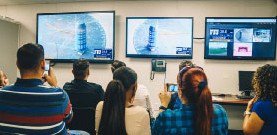
Watching a Challenge test underway.
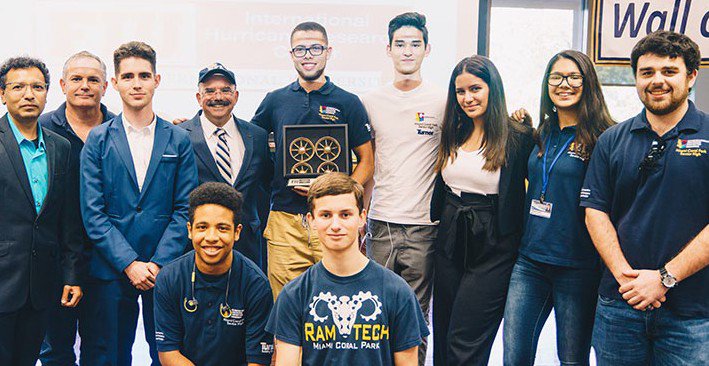
Wall of Wind Challenge winners, 2019.
AN ENGINEERING CHALLENGE FOR HIGH SCHOOLS
One of the most popular outreach efforts for the WOW is the Wall of Wind Mitigation Challenge, which also receives funding from the Florida Division of Emergency Management. Although similar to college-level civil engineering challenges, this one, aimed at South Florida high school students, is arguably more rigorous. As the next generation of engineers to address natural hazards and extreme weather, this STEM education event features a competition between high school teams to develop innovative wind mitigation concepts and real-life human safety and property protection solutions defined by the Wall of Wind research team. Students must build a physical specimen to test, and they also must prepare an oral presentation and a technical paper.
The live testing event is an exciting day at the Wall of Wind facility. Students have their wind-resistant structures tested by the WOW, and their work is judged by the WOW team, local engineering experts, and even TV meteorologists from The Weather Channel and CNN. Local media cover the event, which adds to the days excitement. No matter how students place in the challenge, Salna says, its a once in a lifetime opportunity for the high school students an experience they never forget.
Effort: High. Requires a formal curriculum, faculty involvement, and significant onsite and external organization.
Value: Very high. Local schools get extensive, high-quality exposure to the facility. Media coverage exposes the community to the facilitys role in STEM education and natural hazards mitigation.
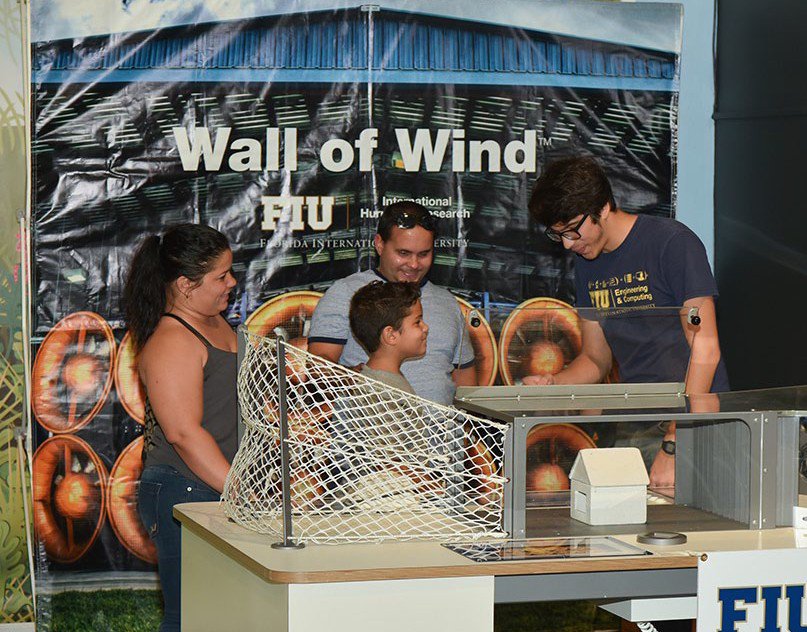
The Wall of Wind Exhibit is popular with families at the Museum of Disovery and Science.
TAKEAWAYS FOR NHERI EXPERIMENTAL FACILITIES
For all outreach efforts, Salna now emphasizes the importance of gathering data on effectiveness, including pre-event and post-event surveys to measure learnings. Social media and website analytics are also useful measures of a programs success.
Get involved with university and local STEM-related events. Develop a web-accessible STEM curriculum and engage with K-12 teachers. Consider simple, inexpensive ways to replicate your facilitys efforts in a classroom. Initiate mutually beneficial relationships with your university and college, local school districts, area museums, and nearby governmental and non-governmental agencies.
For ideas, FIUs Salna recommends checking hazard outreach sites such as NOAAs Education page, STEM-Works, or TeachEngineering. And the NHERI Education and Outreach group is happy to help other Experimental Facilities in outreach efforts.
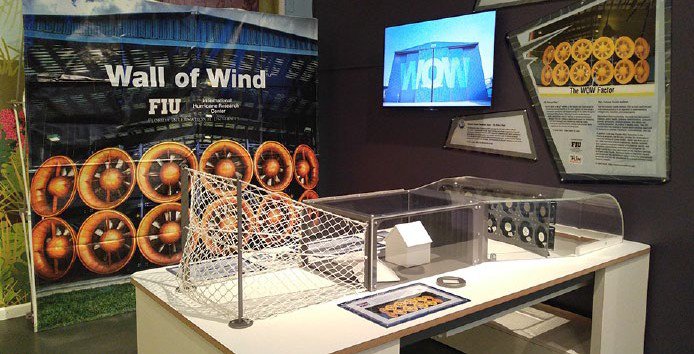
The Wall of Wind Exhibit at the Museum of Discovery and Science.
NHERI Quarterly
Winter 2021
UC San Diego Shake Table to Transform Earthquake Engineering
Case Study: Sustainable Outreach at the FIU Wall of Wind
A Novel Tool for Publishing Social Science, Engineering, and Interdisciplinary Natural Hazards Data
Grants Awarded Using NHERI Facilities and Resources
